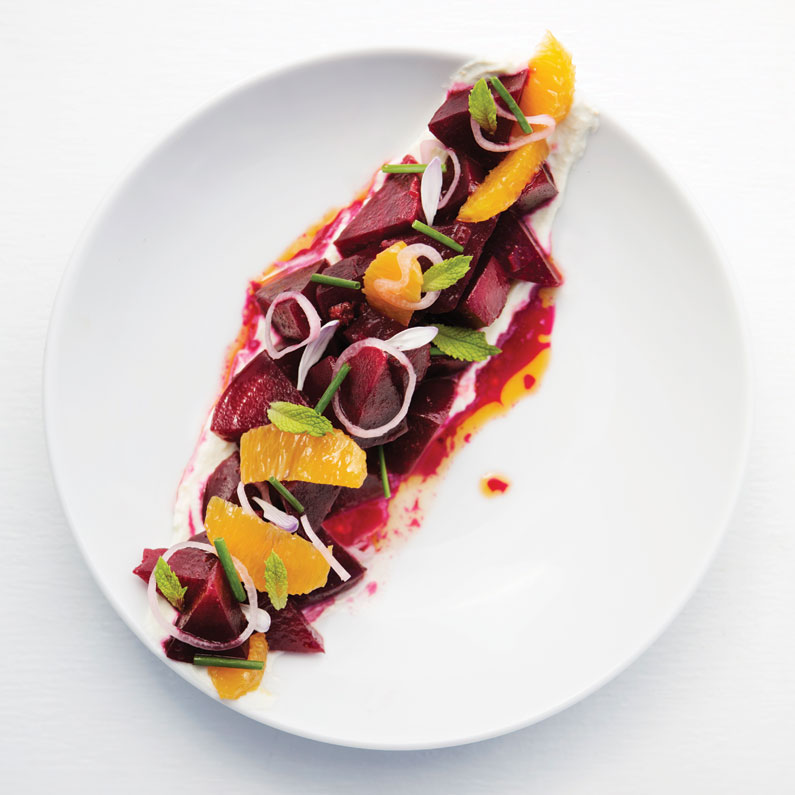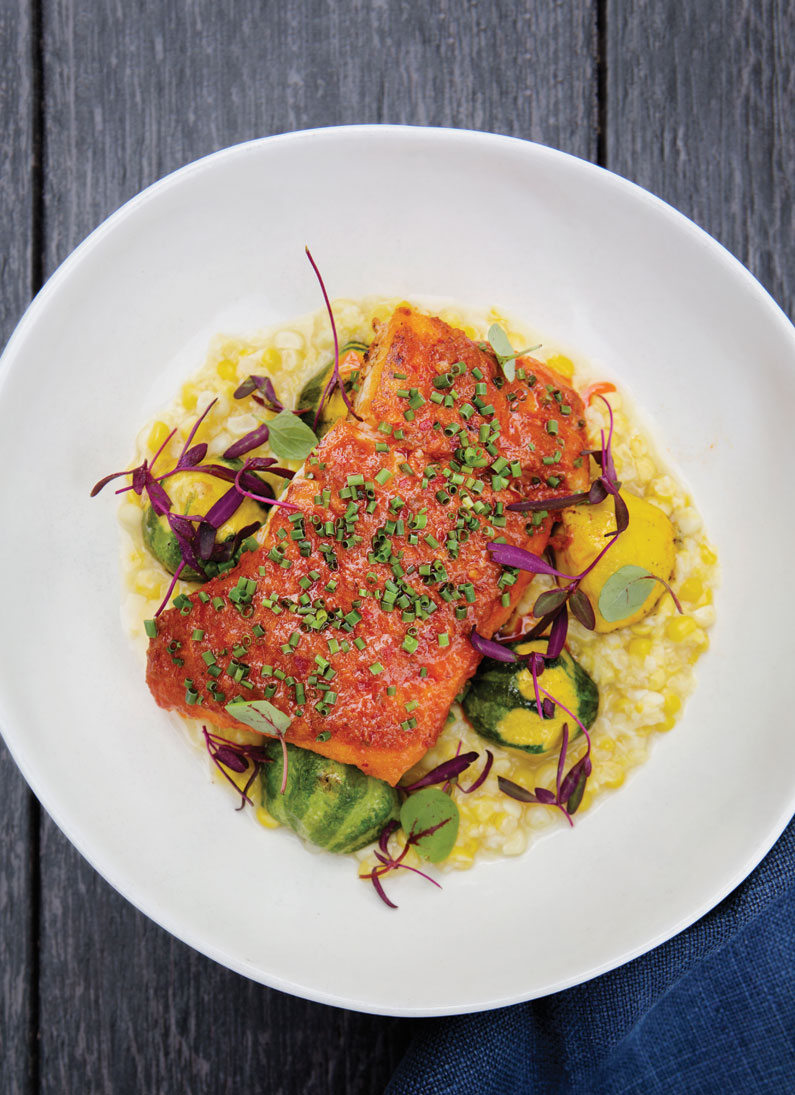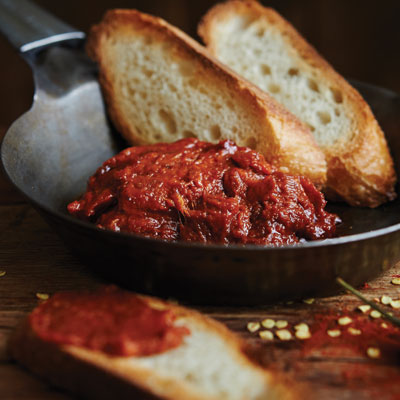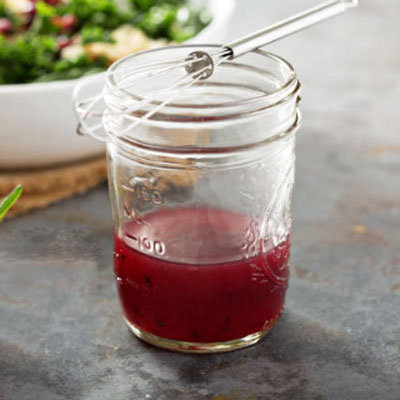Chefs spread the love for spicy 'nduja salami
Consider it the Ferrari of charcuterie: fiery, Italian and everybody wants it. ’Nduja (pronounced en-DOO-ya) is a spicy, spreadable salami that looks like Mexican chorizo and has award-winning chefs and in-the-know home cooks turning up the heat on dishes from pizza to fried eggs.
While ’nduja isn’t mainstream enough to warrant a place on the White Castle menu board, the rising popularity of hot sauces like Sriracha and the continued obsession with bacon makes this fierce pork sausage an odds-on favorite as the next thing to put on everything.
It’s not just deep umami flavor that makes ’nduja so versatile. This southern Italian treat is spreadable. That may sound off-putting, but it allows ’nduja to be served right out of the package, on crostini at room temperature. Or it can be heated until the fat melts, deepening the flavor and pairing well with tomato sauce or a couple slices of cheese like ricotta salata.
Hailing from Calabria, Italy (the toe of the boot that kicks Sicily), ’nduja was originally – as most good things seem to be – peasant food. Traditionally, ’nduja was a mix of pork parts priced right for the hoi polloi, including fatty scraps and shoulder trimmings and sometimes pieces from the head and throat. After finely grinding the pork, the Calabrians would season the meat with the region’s characteristically molten-hot red chiles, then stuff it into a broad section of pig intestine before slow-fermenting and curing the sausage for a month. The ancient result was a kidney-shaped, deep crimson, hell fire-flavored sausage that could be smeared on bread, mixed into pasta sauce or heated and added to just about any dish that cooks wanted to taste like an erupting Mt. Vesuvius.

Current iterations, like that at local salumeria Salume Beddu, replace the offal with pork shoulder for taste, richness and because some traditional parts aren’t available in the United States. Salume Beddu’s rendition also replaces the Calabrian chile with a cayenne-type called goat horn, Santa Fe, New Mexico’s Chimayan chiles and some chiles that Salume Beddu owner Mark Sanfilippo laughingly called “secret” and would not disclose.
“We do Old World sausages with New World flare,” Sanfilippo said. “Our ’nduja isn’t like it is in Italy, and it shouldn’t be.”
It may not be exactly like its Calabrian counterpart, but Sanfilippo’s ’nduja has received the seal of approval from Italian ex-patriot customers, local chefs and national distributors. Eataly in Chicago, a massive market and collection of restaurants featuring high-end Italian food and beverages, buys ’nduja from Salume Beddu, as does highly acclaimed food and wine boutique Picnic in Seattle. Since Salume Beddu started making the sausage three years ago, demand has quadrupled, and the shop now cranks out a 200-pound batch twice a month compared to 200 pounds every other month in 2012.
While Salume Beddu continues to churn out the popular meat spread, the versatility of ’nduja is on full display at restaurants around town. Niche Food Group owner Gerard Craft tempers ’nduja’s heat at Pastaria by pairing it with fresh mozzarella and a drizzle of honey on the Salume Beddu Pizza.
“I’ve always loved ’nduja. It’s chile-forward, fatty and spreadable,” Craft said. “I’m also a huge fan of salty-sweet and spicy-sweet flavor combinations. The ’nduja on the pizza is very spicy, and the mozzarella cools the heat. It all balances.”

It may be spicy, but ’nduja is not hot for the sake of being hot. Well-balanced, it allows the flavor of the pork to come through while providing a simmering, lava-like burn that lingers pleasantly on the palate. To complement the fiery meat, Scott Monteith, chef at newly opened Cellar House in Oakville, uses naan as a flatbread canvas for ’nduja. “It’s so different and unique,” Monteith said. “We render it over low heat with high-quality olive oil and a little chicken stock so it’s more spreadable. We layer it on the flatbread, then thinly sliced pears, blue cheese crumbles and pistachios roughly ground in a food processor.” After baking, the flatbread gets a drizzle of local honey.
Katie Collier, owner of Katie’s Pizza & Pasta in Rock Hill, stays true to ’nduja’s Italitan heritage by adding dollops of the salami to carbonara sauce before pouring that over fresh, house-made paccheri pasta and crowning the dish with pea shoots and leeks.
“I like ’nduja with the carbonara because it seems classic,” Collier said. “I really like spicy food, and it has a smoky heat that is unique and has a beautiful color.”
’Nduja’s adaptable qualities lend it to more than just classic Italian fare. Grapeseed’s Ben Anderson serves ’nduja-crusted halibut, creamed corn and baby patty pan squash for an umami spicy splash against the mild flavor and flakiness of the fish and sweetness of the corn.
All-purpose ’nduja also made its way into a breakfast pastry when Stephanie Fischer, pastry chef and co-owner of Comet Coffee, discovered Salume Beddu’s product and was struck by its smearable quality, which makes it “fun to play around with.”
Fischer rolls the sausage with a couple pieces of ricotta salata, lemon zest and honey in her house-made crescent rolls for a flaky, soft alarm clock for the taste buds.
“The sausage has a good amount of fat, so that renders into the buttery crescent dough during baking,” Fischer said. “The dairy in the crescent and the ricotta salata temper the heat.”
’Nduja’s texture allows it to mix easily into an unexpected vinaigrette. Chef Matt Daughaday will pair the spicy vinaigrette with the sweet earthiness of a smoked beet salad when his Reeds American Table opens later this month at 7322 Manchester Road in Maplewood. Daughaday also recommended using the vinaigrette at home on grilled fish or roasted pork.
“I’ve worked with smoked beets for a long time,” said Daughaday. “A friend introduced me to Salume Beddu’s ’nduja. I like it because it is something different that works really well with the beets.”
Slather it, render it or mix it in. However connoisseurs of capsaicin and fans of flavor apply ’nduja next, the versatile, just-this-side-of-addictive salami is poised to be the hottest Italian import since the classic supercar 458. Buckle in.
BUY THIS
’Nduja is available at Salume Beddu, 3467 Hampton Ave., St. Louis, 314.353.3100,
salumebeddu.com

Paccheri Pasta with ’Nduja Carbonara, Leeks and Pea Shoots
Courtesy of Katie’s Pizza & Pasta’s Katie Collier
4 to 6 servings
1 cup (2 sticks) plus 2 Tbsp. unsalted butter, divided
2 Tbsp. ’nduja
2 Tbsp. extra-virgin olive oil
1 leek, julienned
Kosher salt to taste
Fresh ground black pepper to taste
3 cloves garlic, diced
1 lb. fresh paccheri pasta*
2 egg yolks, beaten
½ cup grated Parmigiano-Reggiano
Handful micro pea shoots to garnish
• Bring a large stockpot of salted water to boil.
• Meanwhile, in the bowl of a food processor, pulse together 1 cup butter and the ’nduja until smooth. Set aside.
• In a large saute pan, warm the oil over high heat. Add the leeks, season with salt and pepper and saute until lightly browned, 2 to 3 minutes. Add the remaining 2 tablespoons butter and cook until the butter foams but does not brown, 1 to 2 minutes. Add the garlic and the ’nduja butter and stir 2 minutes.
• Meanwhile, add the pasta to the boiling water and cook 3 to 4 minutes. Drain the pasta and add it to the sauce, tossing gently. Remove from heat and let rest 30 seconds.
• Add the egg yolks and Parmigiano-Reggiano and toss until the noodles are coated. Season to taste with salt.
• Divide the pasta among serving bowls and garnish with the pea shoots and a drizzle of olive oil.
*Available at Katie’s Pizza & Pasta, 9568 Manchester Road, Rock Hill, 314.942.6555, katiespizzaandpasta.com
’Nduja Flatbread
Courtesy of Cellar House’s Scott Monteith
2 servings
¼ cup roasted, salted pistachios, shelled
1 Tbsp. extra-virgin olive oil
3 to 4 Tbsp. ’nduja
1 5- to 7-inch loaf naan
1 Anjou pear, cored and thinly sliced
¼ cup blue cheese crumbles
Organic honey to taste
• Preheat the oven to 475 degrees.
• In the bowl of a food processor, pulse the pistachios until there is an equal mix of small pieces and fine powder. Set aside.
• In a small nonstick skillet, warm the oil over low heat. Add the ’nduja, gently break it up with a wooden spoon and cook until the fat renders, 3 to 5 minutes.
• Place the naan on a baking sheet. Spread the warm ’nduja atop the naan, leaving a ¼-inch edge. Cover with the pear slices and sprinkle with the blue cheese crumbles and crushed pistachios.
• Bake 8 to 12 minutes. Remove from the oven and drizzle with honey to taste.
Spicy ’Nduja Vinaigrette
Courtesy of Reeds American Table’s Matt Daughaday
3 cups
¾ cup plus 1½ Tbsp. olive oil
¼ cup plus ½ Tbsp. canola oil
1 shallot, minced
3 Tbsp. ’nduja
Zest and juice of 1 orange
1½ cups Champagne vinegar
Pinch of kosher salt
• In a small bowl, whisk together the olive oil and canola oil to blend.
• In a medium saute pan, heat 2 tablespoons blended oil over medium-low heat. Add the shallot and ’nduja. Gently break up the ’nduja with a wooden spoon and cook until the fat renders, about 5 minutes. Remove from heat and let cool to room temperature.
• Meanwhile, in a medium bowl, make a vinaigrette by whisking together the orange zest, orange juice, vinegar and salt. Set aside.
• Whisk the remaining 1 cup blended oil into the cooled ’nduja mixture, then slowly whisk in the vinaigrette.
• Use immediately or cover and refrigerate overnight so the flavors meld. Serve over smoked beets, grilled fish or roasted pork.
Tags : Recipes, Places, Restaurants








